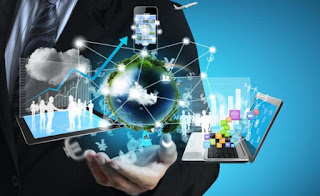Chapter 1: Digital Literacy
World of Technology
People live in a world of technology that has speed up, so do we or we get left behind. In this new age, we have no choice but to grow with it or go live in the mountains off the grid.
Digital literacy involves having a current knowledge and understanding of computers, mobile devices, the Internet, and related technologies uses. It's everywhere.

Computer
Electronic device that operating under the control of instructions stored in its own memory.
Input devices
Hardware that conveys information to one or more people.
Internet
Worldwide collection of networks that connects millions of business, government agencies, educational institutions, and individuals. Users access to the Internet for:
People live in a world of technology that has speed up, so do we or we get left behind. In this new age, we have no choice but to grow with it or go live in the mountains off the grid.
Digital literacy involves having a current knowledge and understanding of computers, mobile devices, the Internet, and related technologies uses. It's everywhere.

Computer
Electronic device that operating under the control of instructions stored in its own memory.
- Accepts data (Collection of unprocessed items) (Input).
- Process data into information ( Conveys meaning and it's useful to people)(Output).
- Produces and stores results.
Input devices
Internet and Networks
Collection of computers and devices
connected together, often wirelessly.
It's used to share:
- Resources
- Hardware devices
- Software programs
- Data
- Information
Server
- Controls access to resources on a network.
- Clients, or workstations, request resources from the server.
Internet
Worldwide collection of networks that connects millions of business, government agencies, educational institutions, and individuals. Users access to the Internet for:
- Communications
- Research and Information
- Shopping
- Banking and Investing
- Classes
- Entertainment
- Download Music
- Share Information
Browser
Software that enables users with an Internet connection to access and view webpages on a computer or mobile device. (Chrome, firefox, ie)
Search engine
Software that finds websites, webpages, images, videos, news, maps, and other information related to a specific topic. (google, yahoo)
Online Social Network
Encourages members to share their internets, ideas, stories, photos, music, and videos with other registered users (fb, Instagram, twitter)
Digital Safety and Security
It is important that users protect their computers and mobile devices from:
- Viruses and Other Malware
- Privacy
- Health Concerns
- Environmental Issues
Green Computing
- It is for reducing the electricity consumed and environmental waste generated when using a computer.
- Strategies include:
- Recycling
- Using energy efficient hardware and energy saving features
- Regulating manufacturing processes
- Extanding the life of computers
- Immediately donating or properly disposing of replaced computers.
Web
Billions of documents, called Web pages, available to anyone connected to the Internet.
- A web site is a collection of related Web pages
- You can share information on a social networking Web site or a photo sharing community
- A podcast is recorded audio stored on a Web site that can be downloaded.
- A web page contains text, graphics, audio, video, and links to other Web pages
- A blog consists of time-stamped articles in a journal format.
Software
- Consists of a series of instructions that tells the computer what to do and how to do it.
- Also called as a program.
Programs and Apps
- Installing is the process of setting up software to work with the computer, printer, and other hardware
- Once installed, you can run an application so that you can interact with it.
- You interact with a program or application through its user interface.
- A software developer, sometimes called an application developer or computer programmer, is someone who develops programs and apps or writes the instructions that direct the computer or mobile devices to process data into information.
Networks
- Home Networks
- Business Networks
Chapter Summary
- Basic computer concepts
- Various methods for input, output, memory, and storage.
- The internet
- Digital security and safety risks and precautions
- Uses of technology applications in society.










Comments
Post a Comment